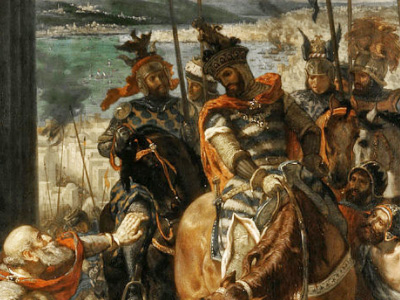Fourth Crusade (1202–04)
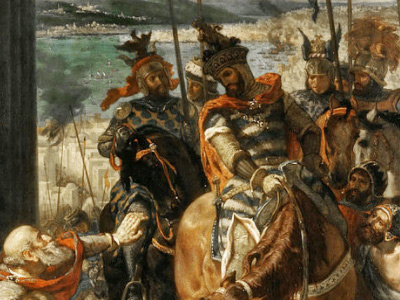
Sack of Constantinople
On 12 April 1204, the weather conditions finally favoured the crusaders. A strong northern wind aided the Venetian ships in coming close to the walls, and after a short battle approximately seventy crusaders managed to enter the city. Some were able to knock holes in the walls, large enough for only a few knights at a time to crawl through; the Venetians were also successful at scaling the walls from the sea, though there was fighting with the Varangians. The Anglo-Saxon "axe bearers" had been amongst the most effective of the city's defenders, but they now attempted to negotiate higher wages from their Byzantine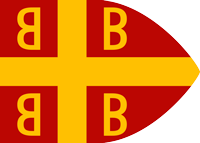 The Byzantine Empire, also referred to as the Eastern Roman Empire or Byzantium, was the continuation of the Roman Empire primarily in its eastern provinces during Late Antiquity and the Middle Ages, when its capital city was Constantinople. It survived the fragmentation and fall of the Western Roman Empire in the 5th century AD and continued to exist for an additional thousand years until the fall of Constantinople to the Ottoman Empire in 1453. employers, before dispersing or surrendering. The crusaders captured the Blachernae section of the city in the northwest and used it as a base to attack the rest of the city. While attempting to defend themselves with a wall of fire, however, they burned even more of the city. This second fire left 15,000 people homeless. The crusaders completely took the city on 13 April.
The Byzantine Empire, also referred to as the Eastern Roman Empire or Byzantium, was the continuation of the Roman Empire primarily in its eastern provinces during Late Antiquity and the Middle Ages, when its capital city was Constantinople. It survived the fragmentation and fall of the Western Roman Empire in the 5th century AD and continued to exist for an additional thousand years until the fall of Constantinople to the Ottoman Empire in 1453. employers, before dispersing or surrendering. The crusaders captured the Blachernae section of the city in the northwest and used it as a base to attack the rest of the city. While attempting to defend themselves with a wall of fire, however, they burned even more of the city. This second fire left 15,000 people homeless. The crusaders completely took the city on 13 April.
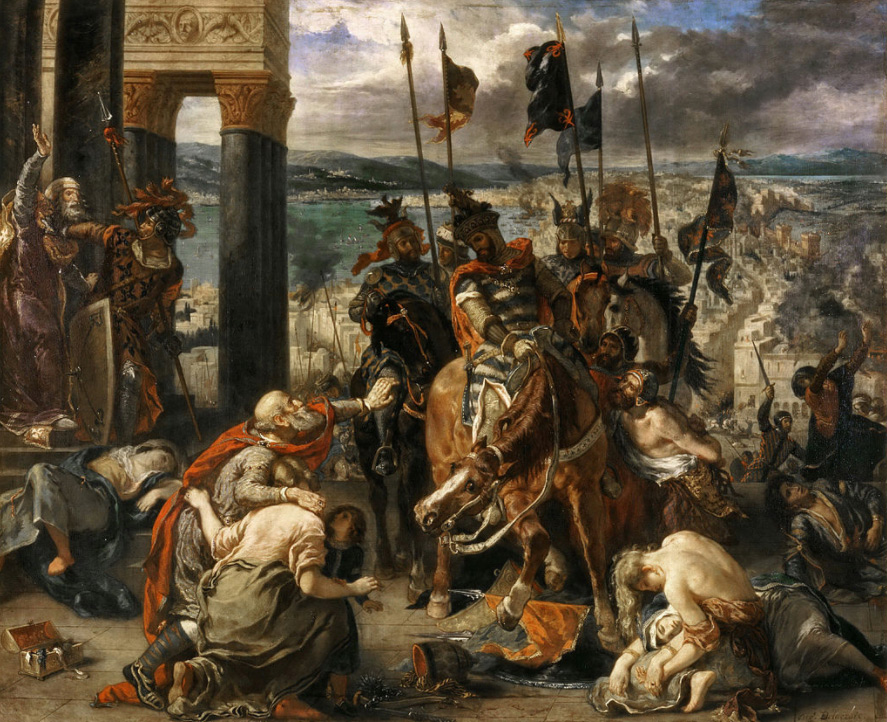
The Entry of the Crusaders into Constantinople (Eugène Delacroix, 1840). The most infamous action of the Fourth Crusade was the sack of the Orthodox Christian city of Constantinople

The Entry of the Crusaders into Constantinople (Eugène Delacroix, 1840). The most infamous action of the Fourth Crusade was the sack of the Orthodox Christian city of Constantinople
( Click image to enlarge)
The crusaders sacked Constantinople for three days, during which many ancient Greco-Roman and medieval Byzantine works of art were stolen or ruined. Many of the civilian population of the city were killed and their property looted. Despite the threat of excommunication, the crusaders destroyed, defiled and looted the city's churches and monasteries. It was said that the total amount looted from Constantinople was about 900,000 silver marks. The Venetians received 150,000 silver marks that was their due, while the crusaders received 50,000 silver marks. A further 100,000 silver marks were divided evenly up between the crusaders and Venetians. The remaining 500,000 silver marks were secretly kept back by many crusader knights.
Speros Vryonis in Byzantium and Europe gives a vivid account of the sack:
The Latin soldiery subjected the greatest city in Europe to an indescribable sack. For three days they murdered, raped, looted and destroyed on a scale which even the ancient Vandals and Goths would have found unbelievable. Constantinople had become a veritable museum of ancient and Byzantine art, an emporium of such incredible wealth that the Latins were astounded at the riches they found. Though the Venetians had an appreciation for the art which they discovered (they were themselves semi-Byzantines) and saved much of it, the French and others destroyed indiscriminately, halting to refresh themselves with wine, violation of nuns, and murder of Orthodox clerics. The Crusaders vented their hatred for the Greeks most spectacularly in the desecration of the greatest Church in Christendom. They smashed the silver iconostasis, the icons and the holy books of Hagia Sophia, and seated upon the patriarchal throne a whore who sang coarse songs as they drank wine from the Church's holy vessels. The estrangement of East and West, which had proceeded over the centuries, culminated in the horrible massacre that accompanied the conquest of Constantinople. The Greeks were convinced that even the Turks, had they taken the city, would not have been as cruel as the Latin Christians. The defeat of Byzantium, already in a state of decline, accelerated political degeneration so that the Byzantines eventually became an easy prey to the Turks. The Fourth Crusade and the crusading movement generally thus resulted, ultimately, in the victory of Islam, a result which was of course the exact opposite of its original intention.
When Innocent III heard of the conduct of his pilgrims he was filled with shame and rage, and he strongly rebuked them. According to a subsequent treaty, the empire was apportioned between Venice and the leaders of the crusade, and the Latin Empire of Constantinople was established. Boniface was not elected as the new emperor, although the citizens seemed to consider him as such; the Venetians thought he had too many connections with the former empire because of his brother, Renier of Montferrat, who had been married to Maria Komnene, empress in the 1170s and 1180s. Instead they placed Baldwin of Flanders on the throne. Boniface went on to found the Kingdom of Thessalonica, a vassal state of the new Latin Empire. The Venetians also founded the Duchy of the Archipelago in the Aegean Sea. Meanwhile, Byzantine refugees founded their own successor states, the most notable of these being the Empire of Nicaea under Theodore Laskaris (a relative of Alexios III), the Empire of Trebizond, and the Despotate of Epirus.
HISTORY
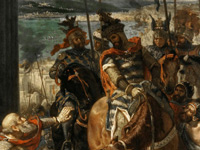
RESOURCES
This article uses material from the Wikipedia article "Fourth Crusade (1202–04)", which is released under the Creative Commons Attribution-Share-Alike License 3.0.
© Stories Preschool. All Rights Reserved.
